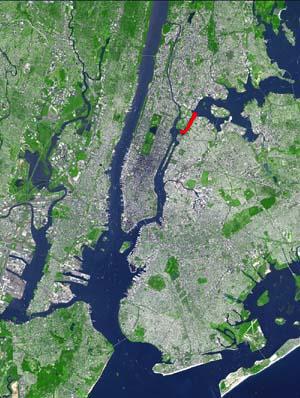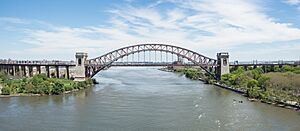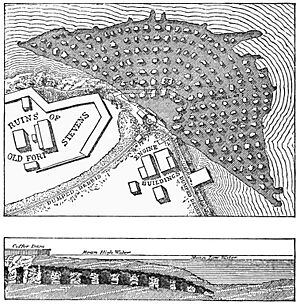Hell Gate facts for kids

Hell Gate is a narrow water passage in the East River in New York City. It separates Astoria, a part of Queens, from Randall's and Wards Islands in Manhattan. This strait is known for its strong currents and was once very dangerous for ships.
Contents
What's in a Name?
The name "Hell Gate" comes from the Dutch phrase Hellegat. It first appeared on a Dutch map as Helle Gadt. A Dutch explorer named Adriaen Block gave it this name. He was the first European to sail through this strait around 1614–1616. He named it after a similar dangerous waterway in the Netherlands.
Some historians think the name "Hellegat" was inspired by the Greek Hellespont, which also had a reputation for being dangerous. Another idea is that it could mean "bright strait" or "clear opening." However, because explorers found the currents and rocks in this New World place very risky, the English version of the name stuck.
The strait was also called Hurl Gate on old maps. This name probably came from Dutch words meaning "whirl" and "hole," describing the whirlpools that formed there.
A Look Back in Time
In October 1776, during the American Revolutionary War, Admiral Howe sailed some British ships through Hell Gate. This was considered a very risky move at the time because of the dangerous waters.
Building Bridges
In 1917, the Hell Gate Bridge was built across Hell Gate. This bridge connects Wards Island and Queens. It created a direct rail link between New England and New York City. Later, in 1936, the Triborough Bridge (now called the Robert F. Kennedy Bridge) was built. This bridge allows cars and trucks to travel between Manhattan, the Bronx, and Queens.
Making the Waterway Safer
For many years, merchants and others wanted to make Hell Gate safer for ships. The mix of strong tides and hidden rocks made it very dangerous.
Early Attempts to Clear Rocks
In 1849, a French engineer named Benjamin Maillefert started clearing some of the rocks. He specialized in underwater blasting. He helped reduce the size of "Pot Rock" to make the water deeper. Even with these efforts, ships still ran aground (about 2% in the 1850s).
The United States Congress provided some money for more clearing work. However, surveys showed the rocks were still a problem. New York City worried it might lose its status as a major port. This was because the main shipping channels were getting shallower. Also, new, larger ships needed deeper water to pass safely.
The Big Blasts
After the American Civil War, the U.S. Congress realized how important clear waterways were for the military. They asked the Army Corps of Engineers to clear Hell Gate. Colonel James Newton led this big project. He estimated it would cost $1 million, but the yearly loss from shipping accidents was about $2 million.
In 1868, Newton decided to focus on a large reef called Hallet's Point Reef, off Queens. Workers dug tunnels under the reef, creating a "swiss cheese" pattern. They then filled these tunnels with 30,000 pounds of dynamite. On September 24, 1876, Newton's daughter set off the explosion. Many people watched, including patients from a hospital on Wards Island. The explosion immediately made the strait less turbulent, and there were fewer accidents. The city's Chamber of Commerce celebrated this "destruction of one of the terrors of navigation." It took until 1891 to clear all the debris from this blast.
Newton also worked on another large reef called Flood Rock. In 1885, Flood Rock was also blown up. This was one of the biggest man-made explosions ever at that time. Newton's daughter again set off the blast. Two years later, plans were made to dredge Hell Gate to a consistent depth of 26 feet.
Hell Gate in Movies and Books
Film
- Hell Gate: The Watery Grave (1977) is a documentary film. It tells the story of the waterway, including how the channel was cleared. It also covers the building of the Hell Gate Bridge.
- Under Hellgate Bridge (1999) is a crime drama film set in Queens. The Hell Gate Bridge is featured in the movie.
- In Gangs of New York (2002), a movie directed by Martin Scorsese, the main character, Amsterdam Vallon, is sent to Hell Gate Orphanage as a child.
Literature
In James Fenimore Cooper's novel The Water-Witch, or, The Skimmer of the Seas (1830), Hell Gate is the setting for an exciting chase. A fast ship called the Water Witch is pursued by a British Royal Navy ship.



